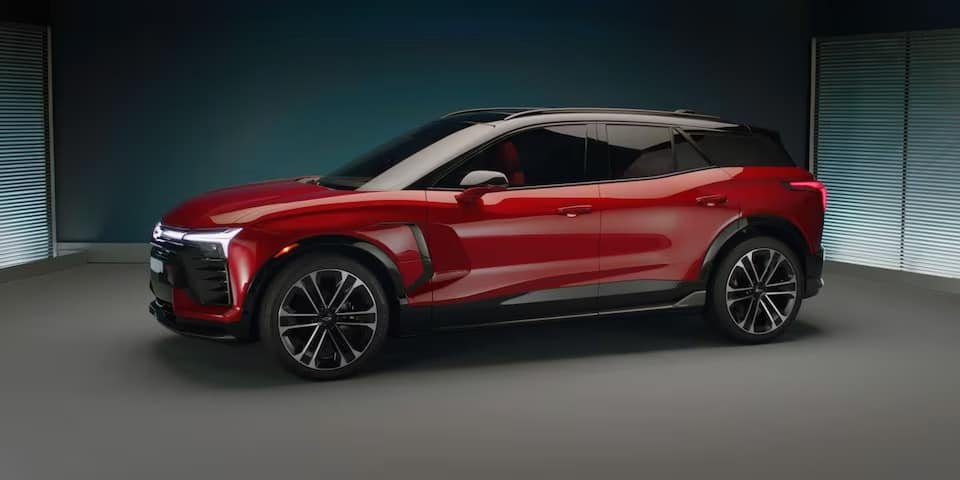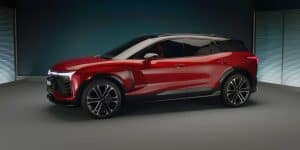The automotive industry is experiencing a significant shift towards electrification, with more and more automakers unveiling electric vehicles (EVs) to meet the growing demand for sustainable and eco-friendly transportation. General Motors (GM), a leading automotive manufacturer, is no exception to this trend. In an exciting development, GM has announced the production of the highly anticipated Chevy Blazer EV, with the all-wheel-drive (AWD) RS model set to lead the charge. This article delves into the details of the upcoming Chevy Blazer EV, exploring its specifications, features, and its potential impact on the EV market.
I. The Chevy Blazer EV: A Step Towards Sustainable Mobility
The Chevy Blazer has long been a popular nameplate in the automotive world, known for its bold design, versatility, and performance. With the transition to electric mobility becoming a priority, GM’s decision to introduce an electric version of the Blazer demonstrates its commitment to sustainability and innovative technology.
The Chevy Blazer EV represents a significant milestone in GM’s electrification strategy, positioning the brand to compete in the growing EV market. As consumers increasingly seek greener and more sustainable transportation options, the Blazer EV aims to offer a compelling choice for those in search of an electrifying driving experience.
II. All-Wheel Drive (AWD) RS Model: Unveiling the Trailblazer
The production of the Chevy Blazer EV begins with the AWD RS model taking the lead. The RS trim level is synonymous with sportiness and performance, and the Blazer EV’s AWD RS model aims to deliver an electrified version of this dynamic driving experience.
Featuring a robust all-wheel-drive system, the AWD RS model is designed to tackle various terrains and weather conditions with ease. Its electric powertrain promises instant torque delivery, enhancing acceleration and providing drivers with a thrilling ride on both highways and winding roads.
III. Electrification Technology: The Heart of the Chevy Blazer EV
The Chevy Blazer EV’s electrification technology lies at the core of its performance and efficiency. GM’s Ultium electric platform serves as the foundation for the Blazer EV’s powertrain, offering a highly versatile and scalable architecture that can accommodate various vehicle sizes and types.
The Ultium platform utilizes advanced battery technology to deliver long-range capabilities and fast charging options. This ensures that the Blazer EV can comfortably handle daily commutes and long journeys, providing drivers with peace of mind and reducing range anxiety.
IV. Design and Aesthetics: The EV Evolution
The Chevy Blazer EV builds upon the iconic design language of its gasoline-powered predecessor, incorporating subtle touches that distinguish it as an electric vehicle. The exterior boasts sleek lines, aerodynamic elements, and unique EV badging, signaling the Blazer EV’s forward-thinking approach.
Inside, the Blazer EV’s cabin exudes modernity and sophistication, with high-quality materials and an intuitive infotainment system. The integration of sustainable and eco-conscious materials aligns with the EV’s green philosophy, creating a harmonious blend of technology and environmental consciousness.
V. Performance and Range: Electric Thrills and Endurance
The AWD RS model of the Chevy Blazer EV is expected to offer impressive performance and range. The instant torque delivery from the electric powertrain is likely to result in rapid acceleration and exhilarating driving dynamics, making it an ideal choice for enthusiasts seeking an electrifying driving experience.
Regarding range, the Blazer EV is expected to boast a competitive figure, allowing drivers to embark on extended journeys with confidence. Fast-charging capabilities further enhance the convenience of recharging, making it feasible for long-distance travels.
VI. Safety and Technology: Cutting-Edge Innovations
As with any modern vehicle, safety and technology play a crucial role in the Chevy Blazer EV’s appeal. Advanced driver-assistance systems (ADAS) are expected to be incorporated, offering features such as adaptive cruise control, lane-keeping assistance, and automatic emergency braking.
The Blazer EV’s infotainment system is likely to offer seamless smartphone integration, voice commands, and wireless connectivity options. Furthermore, an array of connected services and over-the-air updates will keep the Blazer EV current with the latest technology advancements.
VII. Charging Infrastructure: Paving the Way for EV Adoption
The successful adoption of electric vehicles heavily relies on the availability of a robust and widespread charging infrastructure. GM’s commitment to electrification extends beyond vehicle production, with investments in charging infrastructure development.
By collaborating with charging networks and working towards establishing an extensive network of fast-charging stations, GM aims to alleviate concerns related to charging accessibility and convenience, making electric mobility a viable option for consumers.
VIII. A Competitive Landscape: Navigating the EV Market
As GM ventures into the competitive world of electric vehicles, it faces stiff competition from established players and emerging startups in the EV market. Other automakers, such as Tesla, Ford, and Volkswagen, have already made significant strides in the EV sector, garnering substantial consumer interest.
To stand out in this competitive landscape, GM’s marketing strategy for the Chevy Blazer EV will play a crucial role. Leveraging the Blazer’s iconic brand recognition and showcasing the Blazer EV’s unique selling points will be essential in capturing the attention of potential buyers. Emphasizing the Blazer EV’s performance, range, charging capabilities, and sustainable features will be key to differentiating it from its competitors.
Furthermore, GM’s existing dealership network and customer service infrastructure can play a vital role in ensuring a seamless ownership experience for Blazer EV owners. Providing excellent customer support, easy access to charging solutions, and comprehensive after-sales service will enhance the appeal of the Blazer EV to potential buyers.
IX. Environmental Impact and Sustainability: Driving Towards a Greener Future
The shift towards electric vehicles is driven not only by performance and technological advancements but also by the pressing need to reduce greenhouse gas emissions and combat climate change. As an all-electric vehicle, the Chevy Blazer EV has the potential to significantly reduce carbon emissions compared to its gasoline-powered counterparts.
By transitioning to an electric powertrain, the Blazer EV contributes to a cleaner and more sustainable transportation ecosystem. As GM aims to achieve carbon neutrality across its products and operations by 2040, the Blazer EV plays a crucial role in fulfilling this commitment.
X. The Impact of Government Incentives and Regulations
Government incentives and regulations play a significant role in shaping the electric vehicle market. As countries around the world strive to accelerate the adoption of electric mobility, various incentives, such as tax credits, rebates, and reduced registration fees, are offered to encourage consumers to switch to electric vehicles.
GM’s production of the Chevy Blazer EV aligns with the growing demand for electric vehicles and supports governments’ efforts to achieve emission reduction goals. By offering competitive pricing and leveraging government incentives, GM can further boost the appeal of the Blazer EV among consumers.
XI. Addressing Range Anxiety: Charging Solutions and Range Improvements
One of the primary concerns for consumers considering electric vehicles is range anxiety—the fear of running out of battery charge during a journey. To address this concern, GM is likely to invest in improving the Blazer EV’s range capabilities and fast-charging infrastructure.
Expanding the availability of fast-charging stations in urban centers and along highways will enhance the Blazer EV’s practicality for long-distance travel. Additionally, continued advancements in battery technology can lead to range improvements, alleviating range anxiety and further driving EV adoption.
XII. The Role of Blazer EV in GM’s Electrification Strategy
The Chevy Blazer EV represents a significant milestone in GM’s broader electrification strategy. As part of its commitment to offering 30 all-electric models globally by 2025, GM is investing heavily in EV development and production.
The success of the Blazer EV is crucial not only for its individual market presence but also for GM’s overall electrification efforts. A positive reception and strong sales for the Blazer EV can serve as a testament to GM’s ability to deliver compelling electric vehicles that resonate with consumers.
XIII. Consumer Expectations and Driving Experience
The success of the Chevy Blazer EV will ultimately depend on how well it meets consumer expectations and provides an exceptional driving experience. While sustainability and eco-friendliness are significant factors, consumers also prioritize features such as performance, comfort, and advanced technology.
As the Blazer EV enters the market, GM’s focus on delivering a well-rounded product that strikes the right balance between performance, efficiency, and cutting-edge technology will be crucial in winning over consumers and creating a loyal customer base.
XIV. Potential Challenges and Opportunities
Despite the enthusiasm surrounding the Chevy Blazer EV, it faces challenges that are common to many electric vehicles. Factors such as battery production costs, charging infrastructure development, and consumer awareness can influence the Blazer EV’s market penetration and sales.
However, these challenges also present opportunities for growth and innovation. GM’s commitment to investing in battery technology, charging infrastructure, and marketing efforts can help address these challenges and solidify the Blazer EV’s position as a frontrunner in the EV market.
XV. Global Impact: Contributing to an Electric Future
As the Chevy Blazer EV hits the roads, its impact extends far beyond individual markets. By contributing to the global shift towards electric mobility, the Blazer EV plays a role in reducing carbon emissions and mitigating the effects of climate change.
GM’s commitment to sustainability and its contribution to the electrification of transportation align with global efforts to build a more sustainable future. As more automakers join the EV revolution, the collective impact of electric vehicles can lead to significant environmental improvements worldwide.
XVI. Consumer Adoption and Market Potential
The success of the Chevy Blazer EV will largely depend on consumer adoption rates and market potential. As EV technology becomes more accessible, affordable, and familiar to consumers, the market for electric vehicles continues to expand rapidly.
Early adopters and environmentally conscious consumers have already embraced EVs, but the challenge lies in appealing to a broader consumer base. GM’s marketing efforts, partnerships with charging infrastructure providers, and continuous improvements to EV technology will be pivotal in reaching a wider audience.
XVII. Conclusion: Paving the Way for an Electrifying Future
The Chevy Blazer EV’s production and its AWD RS model’s introduction signal GM’s commitment to driving the future of electric mobility. As the automotive industry undergoes a transformative shift towards electrification, the Blazer EV represents a bold step towards a more sustainable and eco-friendly future.
With its electrification technology, AWD capabilities, and innovative design, the Blazer EV aims to deliver an exhilarating and environmentally responsible driving experience. As it enters the market, the Blazer EV carries the potential to capture the imagination of consumers, revolutionize the SUV segment, and solidify GM’s position as a leading player in the electric vehicle market.
As consumers become increasingly conscious of their environmental impact, the Chevy Blazer EV presents an attractive option for those seeking to reduce their carbon footprint without compromising on style or performance. Its sleek design, powerful AWD capabilities, and sustainable driving experience create a compelling package that appeals to a wide range of consumers.
GM’s commitment to expanding charging infrastructure and leveraging government incentives will play a crucial role in addressing consumer concerns about range anxiety and affordability. By ensuring easy access to charging stations and offering competitive pricing, GM can bolster consumer confidence in making the switch to electric mobility.
The success of the Blazer EV will not only depend on its performance in the market but also on the overall electrification strategy pursued by GM and other automakers. As more electric vehicles enter the market and charging infrastructure continues to improve, consumer adoption of EVs is expected to accelerate further.
The Chevy Blazer EV’s journey will be closely watched by industry experts, consumers, and environmental advocates alike. Its impact on the automotive landscape and its potential to influence other automakers’ electrification efforts make it a significant milestone in the transition to a sustainable and electrified future.
In conclusion, the production of the Chevy Blazer EV, with the AWD RS model leading the charge, marks a momentous step in GM’s electrification strategy. As consumer demand for electric vehicles continues to rise, the Blazer EV presents a compelling option that combines style, performance, and sustainability.
The electrification of the automotive industry represents a critical pathway to reducing greenhouse gas emissions, combating climate change, and fostering a more sustainable future. The Blazer EV’s introduction is a testament to GM’s commitment to driving this transformation and solidifying its position as a forward-thinking automotive leader.
As the Blazer EV hits the roads, it will serve as an emblem of progress, innovation, and responsible mobility. Its potential to make a meaningful impact on the electric vehicle market and contribute to a greener and cleaner world underscores the power of the automotive industry to shape a sustainable future.
As consumers embrace the electrifying driving experience and environmental benefits of the Blazer EV, it will pave the way for a new era of mobility—one where electric vehicles play a central role in reducing emissions and creating a more sustainable and interconnected world. The journey towards a greener future starts with the Chevy Blazer EV, and its production marks a pivotal moment in the ongoing evolution of the automotive industry.
XVIII. The Road Ahead: Continuous Innovation and Evolution
The production of the Chevy Blazer EV is just the beginning of GM’s journey towards a more electrified future. As technology continues to evolve and consumer preferences shift, the automotive industry will witness a wave of innovation in electric mobility.
GM’s commitment to developing cutting-edge electric vehicles goes beyond the Blazer EV. With the Ultium platform as a versatile foundation, the company has plans to introduce a diverse lineup of electric vehicles in various segments. This includes electric SUVs, trucks, and even performance-oriented electric vehicles to cater to different consumer demands.
The continuous improvement in battery technology is another area of focus for automakers. As battery efficiency and energy density increase, electric vehicles will see significant improvements in range, charging times, and overall performance. This technological advancement will further enhance the appeal of electric vehicles to a broader audience.
XIX. Leveraging Connectivity and Autonomous Technology
The future of automotive mobility is not only electric but also interconnected and autonomous. GM’s commitment to connected car technology, vehicle-to-everything (V2X) communication, and autonomous driving will complement the electrification efforts.
Integrating smart connectivity features into electric vehicles will enhance the overall driving experience, allowing for seamless access to navigation, entertainment, and real-time vehicle diagnostics. Moreover, autonomous driving capabilities can make electric vehicles more practical and convenient, especially in urban environments.
XX. Sustainability in Manufacturing and Supply Chain
While the focus of the Chevy Blazer EV is on reducing emissions during its operational life, sustainability also extends to its manufacturing process and supply chain. As consumer awareness of environmental impact increases, automakers are under pressure to adopt sustainable practices throughout their operations.
GM’s commitment to sustainability includes reducing waste, conserving resources, and promoting ethical sourcing of materials. By embracing eco-friendly manufacturing processes and supporting responsible mining practices, GM aims to create a more sustainable supply chain that aligns with its commitment to environmental stewardship.
XXI. Collaborations and Partnerships
The success of the electric vehicle industry relies not only on individual automakers’ efforts but also on collaborations and partnerships within the automotive ecosystem. Strategic partnerships with charging infrastructure providers, renewable energy companies, and government entities will play a crucial role in supporting the widespread adoption of electric vehicles.
By working together, stakeholders can accelerate the development of charging infrastructure, improve access to renewable energy, and address regulatory challenges. These collaborations will foster a more conducive environment for electric vehicles to thrive, benefitting both consumers and the planet.
XXII. Consumer Education and Awareness
While electric vehicles have gained popularity, there is still work to be done in educating consumers about the benefits of EVs and addressing common misconceptions. Initiatives aimed at raising awareness about electric vehicle technology, charging infrastructure, and environmental benefits will be instrumental in driving consumer adoption.
Automakers like GM can play a significant role in these efforts by showcasing the advantages of electric vehicles through marketing campaigns, test-drive events, and interactive educational programs. By empowering consumers with accurate information, they can make informed decisions that align with their sustainable lifestyle choices.
XXIII. The Legacy of the Chevy Blazer EV
The production of the Chevy Blazer EV marks a significant milestone in GM’s electrification journey and the evolution of the automotive industry. As one of the iconic nameplates in GM’s lineup, the Blazer’s transition to electric mobility represents a powerful statement about the future direction of the automotive landscape.
The legacy of the Blazer EV will extend beyond its individual sales numbers, inspiring future generations of electric vehicles and pushing the boundaries of what is possible in sustainable mobility. Its impact on consumer perception, environmental consciousness, and industry innovation will be felt for years to come.
XXIV. Conclusion: A Pioneering Step in Electric Mobility
The production of the Chevy Blazer EV, with the AWD RS model leading the charge, is a testament to GM’s commitment to sustainable and innovative mobility solutions. By combining the Blazer’s iconic design and performance with cutting-edge electric technology, GM presents a compelling electric SUV option for consumers seeking an electrifying driving experience.
As the Blazer EV hits the roads, it sets the stage for a transformative shift in the automotive industry. With advancements in battery technology, charging infrastructure, and connected capabilities, electric vehicles are poised to play a central role in the future of mobility.
GM’s electrification strategy goes beyond the Blazer EV, with a comprehensive roadmap of electric vehicles that cater to diverse consumer needs. By embracing sustainability, innovation, and collaboration, GM is driving the transition towards a greener and more interconnected world.
The Chevy Blazer EV represents not only a pioneering step in electric mobility but also a symbol of progress and responsibility in the face of climate change. As consumers increasingly embrace the environmental benefits and exhilarating performance of electric vehicles, the automotive industry will witness a transformative shift towards a cleaner, greener, and electrifying future. The journey towards sustainable mobility has begun, and the Chevy Blazer EV stands at the forefront, ready to lead the way.
XXV. The Global Impact of the Blazer EV
As the Chevy Blazer EV enters the global market, its impact on the automotive landscape is not limited to one region or country. The electrification of transportation is a global endeavor, and the Blazer EV’s introduction contributes to the collective effort to reduce carbon emissions and combat climate change on a worldwide scale.
Different regions and countries have varying levels of infrastructure, regulations, and consumer preferences related to electric vehicles. GM’s ability to adapt the Blazer EV to meet the specific needs of each market will be instrumental in maximizing its global reach and appeal.
The Blazer EV’s success in various regions will depend on factors such as charging infrastructure development, government incentives, consumer awareness, and the availability of renewable energy sources. By understanding and addressing the unique requirements of each market, GM can position the Blazer EV as a competitive option in the global electric vehicle landscape.
XXVI. Future Challenges and Opportunities
As the automotive industry continues its shift towards electric mobility, it will face both challenges and opportunities. Technological advancements and infrastructure development will lead to improved electric vehicle performance, charging capabilities, and range, addressing some of the current concerns associated with electric vehicles.
However, increased competition from other automakers, consumer hesitancy about new technology, and potential supply chain constraints may present challenges. Strategic investments in research and development, marketing, and collaborations with key stakeholders will be vital in overcoming these hurdles and maintaining a competitive edge in the market.
XXVII. The Evolution of Personal Transportation
The Chevy Blazer EV’s production represents a broader evolution in personal transportation. As electric vehicles become more accessible and affordable, they are gradually transforming the way people commute, travel, and experience mobility.
With the integration of smart connectivity, autonomous features, and sustainable design, electric vehicles like the Blazer EV offer a glimpse into the future of transportation. As consumers embrace the benefits of electric mobility, it is conceivable that electric vehicles will eventually become the norm rather than the exception.
XXVIII. Environmental Leadership and Corporate Responsibility
GM’s decision to produce the Chevy Blazer EV aligns with its commitment to environmental leadership and corporate responsibility. As a leading automaker, GM has the potential to influence industry practices and set a positive example for sustainability and ethical business operations.
By investing in electric vehicles, renewable energy, and sustainable manufacturing, GM is taking proactive steps towards minimizing its environmental impact. The company’s dedication to responsible business practices reinforces the message that corporate success can go hand-in-hand with environmental stewardship.
XXIX. Shaping the Mobility of Tomorrow
The automotive industry is at the forefront of shaping the mobility of tomorrow. As electric vehicles become increasingly prevalent, they pave the way for a more sustainable, interconnected, and technologically advanced transportation ecosystem.
The production of the Chevy Blazer EV marks a turning point for GM and the automotive industry at large. It represents a commitment to embracing change, innovation, and progress in pursuit of a cleaner and greener future.
XXX. Conclusion: A Bright and Electrifying Future
The production of the Chevy Blazer EV, with the AWD RS model leading the charge, is a milestone in GM’s electrification journey. It embodies the spirit of progress, sustainability, and innovation that will define the automotive industry’s future.
As consumers embrace the electrifying driving experience, environmental benefits, and cutting-edge technology of electric vehicles, the automotive landscape will undergo a transformative shift. Electric vehicles like the Blazer EV will play a crucial role in reducing carbon emissions, combating climate change, and shaping a brighter and more sustainable future.
GM’s commitment to producing electric vehicles, expanding charging infrastructure, and collaborating with stakeholders demonstrates a holistic approach to driving change in the automotive industry.
The Chevy Blazer EV’s journey is not just about a single vehicle—it symbolizes a broader shift towards electric mobility and responsible transportation. Its legacy will be one of progress, environmental consciousness, and a commitment to shaping a better world for future generations.
As the Blazer EV embarks on its electrifying journey, it carries the hopes and aspirations of an industry in transition. With every mile driven, it brings us closer to a greener and more electrifying future—one where sustainable mobility is not just a possibility, but a reality. The road ahead is bright, and the Chevy Blazer EV stands ready to lead us into a new era of sustainable and electrifying transportation.































